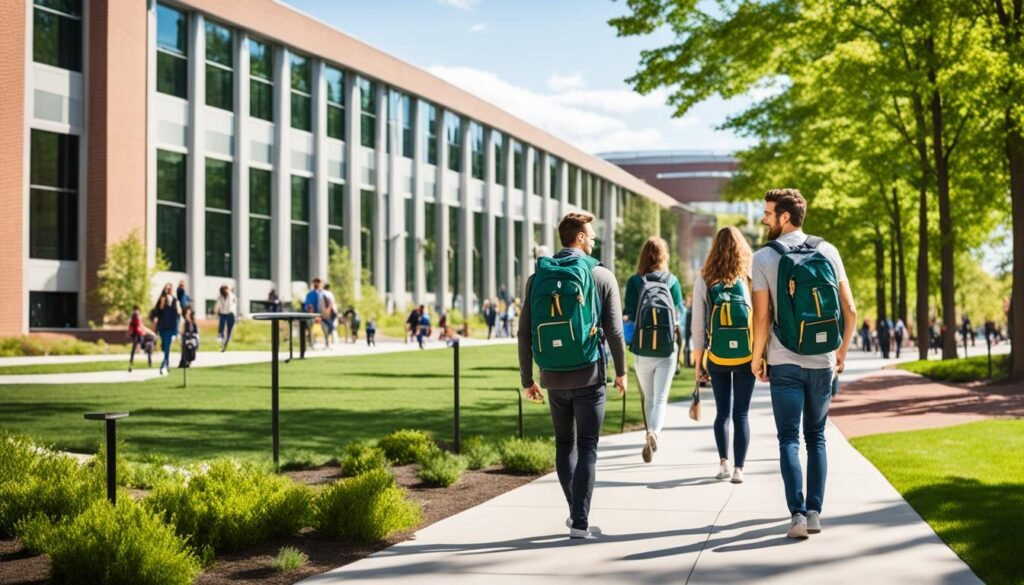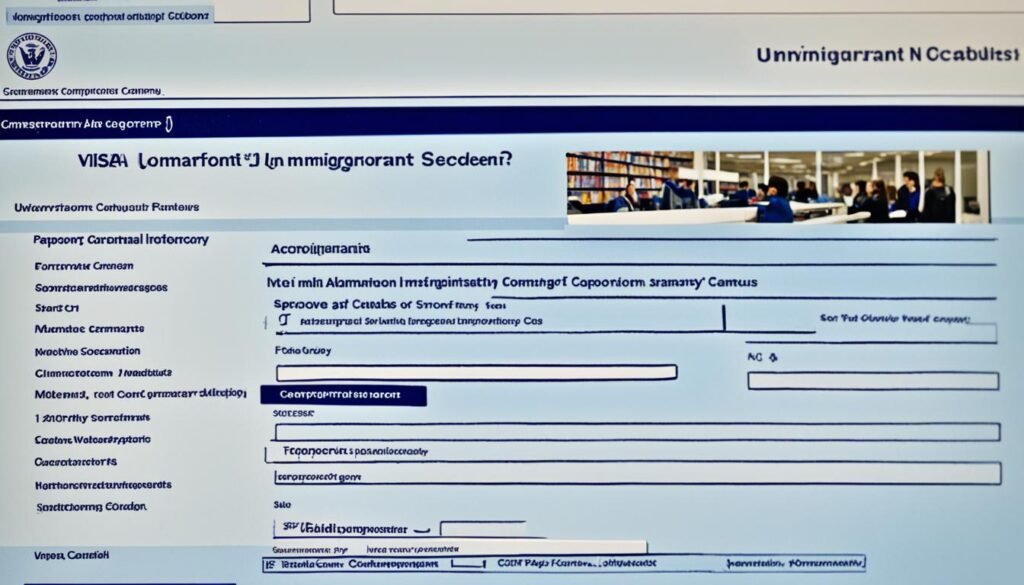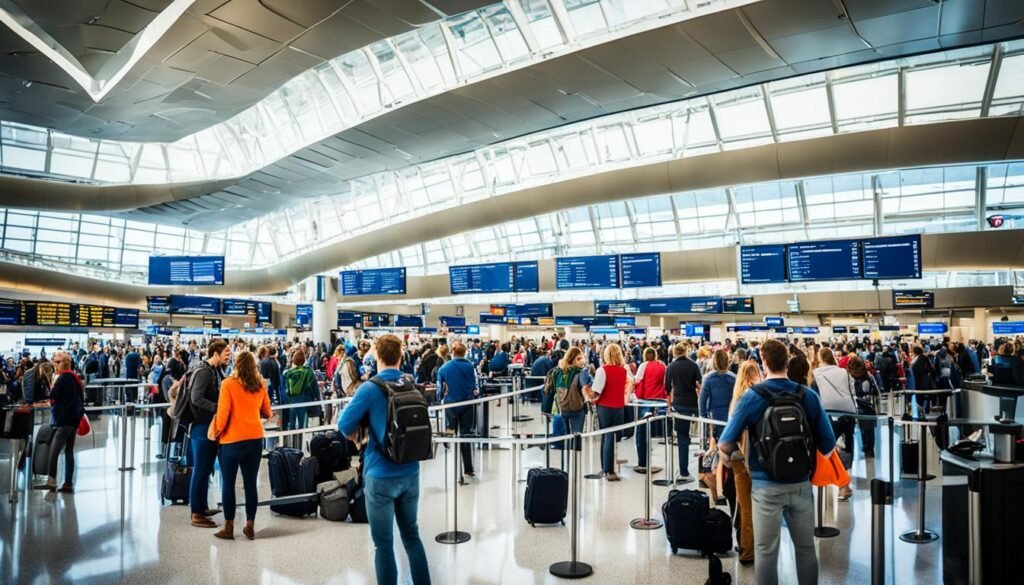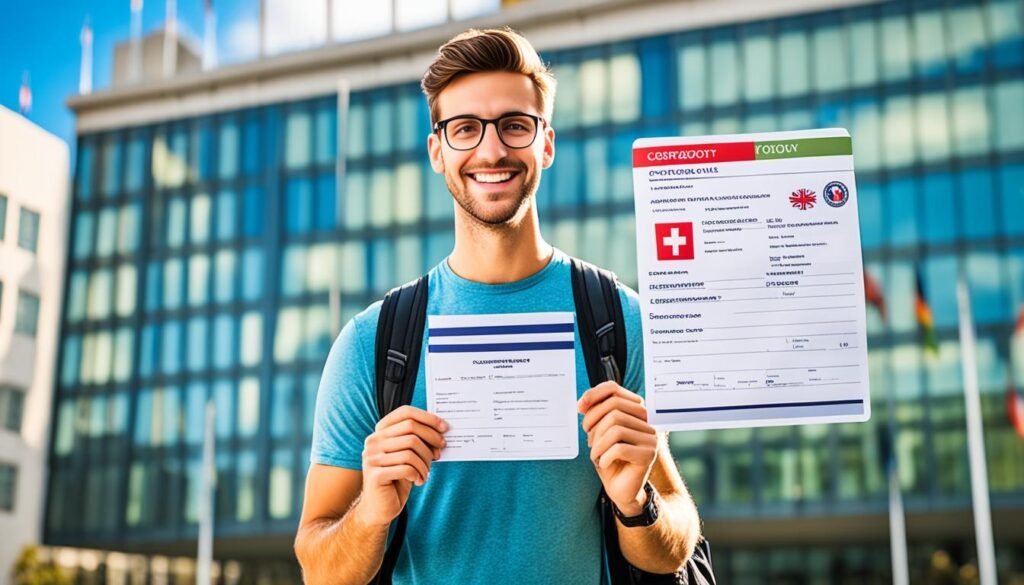University Student Visa : Studying in the United States as an international student means you need a student visa. The visa type depends on your course and the school you’ll attend. Most students need an F-1 visa for academic studies or an M-1 visa for vocational training. It’s key to know the visa requirements and how to apply for a U.S. student visa to smoothly move to studying in the U.S.
Key Takeaways : University Student Visa
- International students must obtain a student visa, either an F-1 or M-1, to study in the United States.
- The type of visa required depends on the type of school and program you plan to attend.
- The student visa application process involves completing an online application, attending an interview at a U.S. embassy or consulate, and meeting various requirements.
- Securing a student visa can take several weeks or months, so it’s important to apply well in advance of your planned start date.
- Maintaining valid student status is crucial throughout your studies in the U.S.
Overview of Student Visas
Going to school in another country can be complex, especially with student visas for the United States. As an international student, knowing about the different visas is key. You need to pick the right one for your studies and personal goals.
Types of Student Visas
The United States has three main student visas: the F-1 visa, the J-1 visa, and the M-1 visa. The F-1 visa lets students attend a university, college, or other schools. The J-1 visa is for those in exchange programs. The M-1 visa is for non-academic or vocational training.
Difference Between Student and Visitor Visas
Students need a student visa (F, J, or M) to study in the United States. They can’t use the Visa Waiver Program or a Visitor (B) visa. For short, fun classes, a Visitor (B) visa might work. But, it’s not for getting a U.S. degree or certificate.
“Navigating the complex world of student visas can be daunting, but understanding the different options is crucial for international students seeking to study in the United States.”
Student Acceptance at SEVP-Approved School
The first step to study in the United States is to apply to a SEVP-approved school. If the school accepts you, you’ll be put in the Student and Exchange Visitor Information System (SEVIS). You’ll also need to pay the SEVIS I-901 fee. Then, the school will give you a Form I-20.
Once you have the Form I-20 and are in SEVIS, you can apply for a student visa at a U.S. Embassy or Consulate. Bring the Form I-20 to your visa interview. If your spouse and/or children will join you, they must also sign up in SEVIS, get their own Form I-20, and apply for a visa. But they don’t pay the SEVIS fee.
“The first step to studying in the United States is to apply to a SEVP-approved school.”
The Student and Exchange Visitor Program (SEVP) is part of the U.S. Department of Homeland Security’s (DHS) Immigration and Customs Enforcement (ICE) agency. SEVP manages the Student and Exchange Visitor Information System (SEVIS). This system keeps track of international students and visitors in the U.S.
- Apply to a SEVP-approved school
- Get accepted by the school
- Register in SEVIS and pay the SEVIS I-901 fee
- Receive the Form I-20 from the school
- Apply for a student visa at a U.S. Embassy or Consulate
This process makes sure international students follow DHS Study in the States rules. It lets them legally study in the United States.
University Student Visa Application Process
Applying for a university student visa in the United States involves several steps. First, you must fill out the online nonimmigrant visa application, known as Form DS-160. This form asks for your personal details, travel plans, and a photo that meets certain photograph requirements.
Then, you’ll set up an interview appointment at the U.S. Embassy or Consulate in your home country. The wait for an interview can be long, so apply early. Before your interview, pay the non-refundable visa application fee. You’ll also need your valid passport, DS-160 confirmation page, and Form I-20 from the SEVP-approved school you’re attending.
Prepare for Your Interview
At the visa interview, the officer might ask for more additional documentation. This could include proof of your academic background, your plans to leave the U.S. after your studies, and how you’ll pay for your education and living costs. Be ready to talk about your plans and qualifications in detail.
| Required Documentation | Additional Documentation |
|---|---|
|
|
The visa application process takes time, so start early and prepare well. By following these steps, you’ll be ready for your university student visa and can start your studies in the United States.
University Student Visa Interview
A consular officer will interview you to see if you can get a university student visa. You must show you meet the U.S. law requirements for the visa. You’ll also give ink-free, digital fingerprint scans during the interview.
Interview Requirements
The officer will check if you’re eligible for a student visa. They’ll look at your education, money, and ties to your home country. Be ready to talk about your study plans, how you’ll pay for school, and why you chose the U.S.
Potential Interview Questions
- Why do you want to study in the United States?
- What are your academic and career goals?
- How will you finance your studies in the U.S.?
- What are your plans after completing your degree?
- Do you have any family or other ties that will require you to return to your home country?
After the interview, the officer might say you need more processing. If approved, you might pay a visa fee (if needed) and arrange for your passport and visa to be sent back. Check the visa processing times for more info.
“The visa interview is a crucial step in the university student visa application process. It’s an opportunity for the consular officer to assess your qualifications and determine whether you are likely to return to your home country after your studies.”
| Requirement | Description |
|---|---|
| Fingerprint Scans | You will provide ink-free, digital fingerprint scans as part of the visa application process, usually during the interview. |
| Administrative Processing | If the consular officer determines that your application requires further administrative processing, you may experience delays in the visa issuance. |
| Visa Issuance Fee | If your visa is approved, you may need to pay a visa issuance fee, depending on your nationality. |
Entering the United States
Getting a university student visa is the first step to your journey to the United States. After getting your visa, you must enter the country successfully. Remember, a visa doesn’t automatically let you into the U.S. It lets you travel to a U.S. port-of-entry and ask for permission to enter.
At the port-of-entry, usually an international airport, you’ll show your passport, visa, and Form I-20 to CBP officials. These officials can let you in or deny your entry. They check your documents and decide if you can come into the country. If they say yes, they’ll stamp your passport or give you a paper Form I-94, which is your Arrival/Departure Record.
Students with F or M visas should check the CBP website for info on arriving in the U.S. Make sure you know what you can bring and follow all the rules for entry. This will help you have a smooth arrival in the United States.
| Requirement | Description |
|---|---|
| Passport | A valid passport with an expiration date at least 6 months beyond the intended period of stay in the U.S. |
| Visa | A valid university student visa (F or M) that was issued for your intended program of study. |
| Form I-20 | The Certificate of Eligibility for Nonimmigrant Student Status, which was issued by your SEVP-approved school. |
“Remember, a visa is not a guarantee of entry – it merely allows you to request permission to enter the U.S. at the port-of-entry. Compliance with all entry requirements is essential for a successful arrival.”
Extending Your Stay
Foreign students in the U.S. with F visas must leave the country within 60 days after their program ends. This includes any extra training they’re allowed. But, they can ask for more time through the U.S. Citizenship and Immigration Services (USCIS) website.
It’s important to know the rules and deadlines from the Student and Exchange Visitor Program (SEVP) to keep your immigration status. The SEVP website has lots of info on how to stay in good standing as a student in the U.S.
| Requirement | Description |
|---|---|
| F Visa | Foreign students in the U.S. must hold an F visa to pursue academic studies. |
| Program End Date | The date listed on the Form I-20 that indicates the completion of your academic program. |
| Form I-20 | The main document that shows you’re allowed to study in the U.S. as an international student. |
| USCIS | The U.S. Citizenship and Immigration Services agency that handles the extension process. |
| SEVP Website | The official website of the Student and Exchange Visitor Program, with tips on keeping your immigration status. |
Knowing the rules and deadlines from the SEVP helps you extend your stay smoothly. It also keeps your immigration status in check during your studies in the U.S.
“Staying informed and proactive about the visa extension process is crucial for international students to avoid any disruptions to their studies.”
University Student Visa Requirements
To get a university student visa (F-1 visa) in the United States, you must meet certain criteria. First, the college or university you want to attend must be approved by the Student and Exchange Visitor Program (SEVP). This institution certification shows the school is up to standard for international students.
You also need to be a full-time student at the school during your term. Keeping this status is key to keeping your visa valid.
Showing you can speak English well is another important step. If you don’t meet the language level needed, you might need to take English courses first.
You must also show you have enough money for your studies and living costs in the United States. This usually means showing you have funds from personal, family, or school resources.
- Your valid passport must be good for at least six months after your stay in the United States ends.
- Last, you must have a residence in your home country you plan to go back to after your studies.
Meeting all these requirements is key to getting a university student visa and reaching your education goals in the United States.
“The key to a successful university student visa application is ensuring you meet all the necessary requirements from the start.”
Also Read : Explore Higher Learning Opportunities in the USA
Conclusion
Getting a university student visa to study in the U.S. is a detailed process. First, students need to get accepted by a school that the SEVP approves and get an I-20 form. Then, they must pay the SEVIS fee and fill out the DS-160 visa application.
They also need to schedule and go to a visa interview and bring the right documents. If they get approved, they’ll get their F-1 visa and can come to the U.S. They must keep their student status while they study.
It’s key for international students to know the F-1 visa rules and how to apply. This helps them start their studies in the U.S. and grow both in school and life.
If you’re an international student getting ready for school or a school helping students, this guide is very helpful. It makes sure the visa application and interview go smoothly.
FAQs
Q: What is the F-1 visa for international students?
A: The F-1 visa is a non-immigrant student visa that allows international students to attend academic programs in the United States. It is specifically designed for those who wish to study at an accredited college or university.
Q: What are the requirements to apply for an F-1 visa?
A: To apply for your F-1 visa, you must be accepted by a Student and Exchange Visitor Program (SEVP)-approved school, demonstrate sufficient financial resources to cover your tuition and living expenses, and have a valid passport. Additionally, you need to pay the application fee.
Q: How can I schedule my F-1 visa interview?
A: You can schedule your F-1 visa interview by visiting the website of the U.S. embassy or consulate in your country. After completing the DS-160 form and paying the application fee, you will be able to select a date and time for your visa interview.
Q: What should I expect during the F-1 visa interview?
A: During the F-1 visa interview, a visa officer will ask you questions regarding your study plans, financial situation, and ties to your home country. It’s essential to be honest and provide clear answers to demonstrate your intent to study in the U.S. and return home afterward.
Q: What is the processing time for an F-1 visa?
A: The processing time for an F-1 visa can vary based on the U.S. embassy or consulate where you apply. Generally, it can take anywhere from a few days to several weeks. It’s advisable to apply for your visa in time to ensure you can start your studies as planned.
Q: What should I do if my F-1 visa application is denied?
A: If your F-1 visa application is denied, you will receive a reason for the denial. You can address the issues raised and reapply, or you may consider appealing the decision if you believe it was unjust. It’s crucial to understand the reasons for visa denials to avoid repeating mistakes.
Q: How can I maintain my F-1 visa status while studying?
A: To maintain your F-1 visa status, you must remain enrolled in a full-time academic program, comply with the terms of your visa, and keep your information updated with your Designated School Official (DSO). It’s also important to avoid working without proper authorization.
Q: Can I work while on an F-1 visa?
A: Yes, F-1 visa holders can work under specific conditions. You may work on-campus without special permission, but for off-campus employment, you’ll need to apply for Optional Practical Training (OPT) or Curricular Practical Training (CPT) and obtain approval from your DSO.
Q: What happens if I want to change my school while on an F-1 visa?
A: If you wish to change schools while on an F-1 visa, you must inform your current school and obtain a transfer release. You will then need to be accepted by the new school and update your SEVIS record to reflect the change.
Source Links
- https://educationusa.state.gov/your-5-steps-us-study/apply-your-student-visa/undergraduate
- https://shorelight.com/student-stories/student-visa-usa-f1/
- https://travel.state.gov/content/travel/en/us-visas/study/student-visa.html










